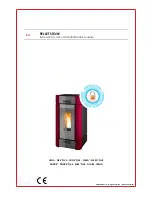
Not recommended as fuel:
Green or damp wood reduces stove efficiency and soils the glass, the internal walls and the flue (soot,
tar, etc.).
Used timber. Burning treated wood (railway sleepers, telegraph poles, off cuts of plywood or chip
board, pallets, etc.) quickly clogs the flue ways (soot, tar,) etc, pollutes the environment (pollution and
smell,) etc, and cause the fire to burn too quickly and overheat.
“Green wood” and “recovered wood” can eventually cause a chimney fire.
Prohibited fuel
:
Plastic bags and any form of bituminous coal or petroleum based coke.
Do not use the appliance as an
incinerator or use any liquid fuels.
This is very dangerous, may damage the product and pollute
the atmosphere
.
3.2 Use
Odours when using the stove for the first time
Painted products:
The stove may emit an irritating gas when used for the first time, and it may smell a little. The gas is
not toxic, but the room should be thoroughly ventilated. Let the fire burn with a high draught until all
traces of the gas have disappeared and no smoke or smells can be detected. Evacuate all people from
the room until all odours have cleared. If for any reason the odours do not clear, extinguish the fire &
seek professional assistance.
Enameled products:
Condensation may form on the surface of the stove the first few times it is used. This must be wiped
off to prevent permanent stains forming when the surface heats up, taking adequate precautions and
protection from the hot stove surface.
Air Control: See figure 4
Always use the key provided to operate the air controls
The amount of heat emitted by the stove is regulated using three air controls.
The primary air supply, where air passes up through the riddling grate, is controlled using the rotating
air control situated below the glass on the front door, turn clockwise to close and anti clockwise to
open.
The secondary air (air wash system), which is supplied to the combustion over the glass, is controlled
using the upper air control lever, move to the left to close and to the right to open.
A third air inlet (normally named tertiary air) provides a constant, pre-heated air supply to the
combustion just above the fire, this is controlled using the push, pull air control below the ash lip
between the legs of the stove. This air supply normally does not require to be regulated. Normally it
will be necessary to keep this air supply open.







































